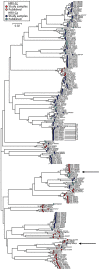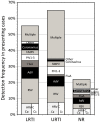Genetics, recombination and clinical features of human rhinovirus species C (HRV-C) infections; interactions of HRV-C with other respiratory viruses
- PMID: 20041158
- PMCID: PMC2794544
- DOI: 10.1371/journal.pone.0008518
Genetics, recombination and clinical features of human rhinovirus species C (HRV-C) infections; interactions of HRV-C with other respiratory viruses
Abstract
To estimate the frequency, molecular epidemiological and clinical associations of infection with the newly described species C variants of human rhinoviruses (HRV), 3243 diagnostic respiratory samples referred for diagnostic testing in Edinburgh were screened using a VP4-encoding region-based selective polymerase chain reaction (PCR) for HRV-C along with parallel PCR testing for 13 other respiratory viruses. HRV-C was the third most frequently detected behind respiratory syncytial virus (RSV) and adenovirus, with 141 infection episodes detected among 1885 subjects over 13 months (7.5%). Infections predominantly targeted the very young (median age 6-12 months; 80% of infections in those <2 years), occurred throughout the year but with peak incidence in early winter months. HRV-C was detected significantly more frequently among subjects with lower (LRT) and upper respiratory tract (URT) disease than controls without respiratory symptoms; HRV-C mono-infections were the second most frequently detected virus (behind RSV) in both disease presentations (6.9% and 7.8% of all cases respectively). HRV variants were classified by VP4/VP2 sequencing into 39 genotypically defined types, increasing the current total worldwide to 60. Through sequence comparisons of the 5'untranslated region (5'UTR), the majority grouped with species A (n = 96; 68%, described as HRV-Ca), the remainder forming a phylogenetically distinct 5'UTR group (HRV-Cc). Multiple and bidirectional recombination events between HRV-Ca and HRV-Cc variants and with HRV species A represents the most parsimonious explanation for their interspersed phylogeny relationships in the VP4/VP2-encoding region. No difference in age distribution, seasonality or disease associations was identified between HRV-Ca and HRV-Cc variants. HRV-C-infected subjects showed markedly reduced detection frequencies of RSV and other respiratory viruses, providing evidence for a major interfering effect of HRV-C on susceptibility to other respiratory virus infections. HRV-C's disease associations, its prevalence and evidence for interfering effects on other respiratory viruses mandates incorporation of rhinoviruses into future diagnostic virology screening.
Conflict of interest statement
Figures





Similar articles
-
Prevalence and clinical characterization of a newly identified human rhinovirus C species in children with acute respiratory tract infections.J Clin Microbiol. 2009 Sep;47(9):2895-900. doi: 10.1128/JCM.00745-09. Epub 2009 Jul 22. J Clin Microbiol. 2009. PMID: 19625482 Free PMC article.
-
Prevalence of human rhinovirus in children admitted to hospital with acute lower respiratory tract infections in Changsha, China.J Med Virol. 2014 Nov;86(11):1983-9. doi: 10.1002/jmv.23861. Epub 2014 Jan 6. J Med Virol. 2014. PMID: 24390928 Free PMC article.
-
Screening respiratory samples for detection of human rhinoviruses (HRVs) and enteroviruses: comprehensive VP4-VP2 typing reveals high incidence and genetic diversity of HRV species C.J Clin Microbiol. 2009 Dec;47(12):3958-67. doi: 10.1128/JCM.00993-09. Epub 2009 Oct 14. J Clin Microbiol. 2009. PMID: 19828751 Free PMC article.
-
Proposals for the classification of human rhinovirus species C into genotypically assigned types.J Gen Virol. 2010 Oct;91(Pt 10):2409-19. doi: 10.1099/vir.0.023994-0. Epub 2010 Jul 7. J Gen Virol. 2010. PMID: 20610666 Review.
-
Review on Clinical and Molecular Epidemiology of Human Rhinovirus-Associated Lower Respiratory Tract Infections in African and Southeast Asian Children.Pediatr Infect Dis J. 2018 Jul;37(7):e185-e194. doi: 10.1097/INF.0000000000001897. Pediatr Infect Dis J. 2018. PMID: 29893746
Cited by
-
Sequencing human rhinoviruses: direct sequencing versus plasmid cloning.J Virol Methods. 2015 Jan;211:64-9. doi: 10.1016/j.jviromet.2014.09.020. Epub 2014 Oct 5. J Virol Methods. 2015. PMID: 25286177 Free PMC article.
-
Rhinoviruses and Respiratory Enteroviruses: Not as Simple as ABC.Viruses. 2016 Jan 11;8(1):16. doi: 10.3390/v8010016. Viruses. 2016. PMID: 26761027 Free PMC article. Review.
-
Viruses and bacteria in acute asthma exacerbations--a GA² LEN-DARE systematic review.Allergy. 2011 Apr;66(4):458-68. doi: 10.1111/j.1398-9995.2010.02505.x. Epub 2010 Nov 18. Allergy. 2011. PMID: 21087215 Free PMC article.
-
Rhinovirus infections in western Sweden: a four-year molecular epidemiology study comparing local and globally appearing types.Eur J Clin Microbiol Infect Dis. 2013 Jul;32(7):947-54. doi: 10.1007/s10096-013-1832-x. Epub 2013 Feb 23. Eur J Clin Microbiol Infect Dis. 2013. PMID: 23435753 Free PMC article.
-
Respiratory pathogens and clinical outcomes in children with an asthma exacerbation: A systematic review.J Assoc Med Microbiol Infect Dis Can. 2019 Oct 11;4(3):145-168. doi: 10.3138/jammi.2019-0004. eCollection 2019 Oct. J Assoc Med Microbiol Infect Dis Can. 2019. PMID: 36340656 Free PMC article. Review.
References
-
- Stanway G, Brown F, Christian P, Hovi T, Hyypia T, et al. Family Picornaviridae. In: Fauquet CM, Mayo MA, Maniloff J, Desselberger U, Ball LA, editors. Virus Taxonomy. Eighth Report of the International Committee on Taxonomy of Viruses. London: Elsevier/Academic Press; 2005. pp. 757–778.
-
- Uncapher CR, DeWitt CM, Colonno RJ. The major and minor group receptor families contain all but one human rhinovirus serotype. Virology. 1991;180:814–817. - PubMed
-
- Vesa S, Kleemola M, Blomqvist S, Takala A, Kilpi T, et al. Epidemiology of documented viral respiratory infections and acute otitis media in a cohort of children followed from two to twenty-four months of age. Pediatr Infect Dis J. 2001;20:574–581. - PubMed
MeSH terms
LinkOut - more resources
Full Text Sources

